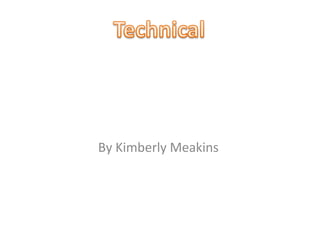
Presentationtech
- 3. EWS (Extreme Wide Shot) The view is so far from the subject that he isn't even visible. Often used as an establishing shot VWS (Very Wide Shot)The subject is visible (barely), but the emphasis is still on placing him in his environment. WS (Wide Shot)The subject takes up the full frame, or at least as much as comfortably possible. CU (close up) Were the subject takes up the frame you can also have mid close up and extreme. Cut-In Shows some (other) part of the subject in detail. CA (Cutaway) A shot of something other than the subject. Two-Shot A shot of two people, framed similarly to a mid shot. (OSS) Over-the-Shoulder Shot Looking from behind a person at the subject. Noddy Shot Usually refers to a shot of the interviewer listening and reacting to the subject. Point-of-View Shot (POV) Shows a view from the subject's perspective. Weather Shot The subject is the weather. Can be used for other purposes, e.g. background for graphics.
- 4. A spotlight is general term for any lighting instrument used in theatre to create a pool of light on the stage. There are many different types of spotlights which break down into three general areas: Fresnel lanterns are small fixtures giving a soft-edged spot or pool of light. Profile spots tend to be longer fixtures containing convex lenses and having a gate at their focal point which enables the insertion of gobos or irises to shape the beam of light. They give a hard-edged beam most often associated in the public mind with "spotlights". Large versions are operated by a technician as a 'followspot' to follow performers on the stage. Pebble Convex lanterns (or "PCs") are similar to Fresnel's, but use a Plano-convex lens with a pebbled effect on the planar (flat) side, resulting in less "spill" outside the main beam. Strip lights, also known as cyclorama or cyc lights. Lamps are often covered with gels of multiple colours (often red, green, and blue, which, in theory, allow almost any colour to be mixed) with each colour controlled by a separate electrical dimmer circuit. Scoop lights or scoops are circular fixtures that do not have any lenses. They have an ellipsoidal reflector at the back of the fixture that directs the light out of the fixture. Low key lighting and High key lighting to show the time of day or to induce the tension and atmosphere. In cinematography, the use of light can influence the meaning of a shot. For example, film makers often portray villains that are heavily shadowed or veiled, using silhouette.
- 5. Diegetic sound: It is sound that the characters can hear as well as the audience, and usually implies a reaction from the character. Also called "literal sound" or "actual sound": Voices of characters; Sounds made by objects in the story, e.g. heart beats of a person Source music, represented as coming from instruments in the story space. Basic sound effects, e.g. dog barking, car passing; as it is in the scene Music coming from reproduction devices such as record players, radios, tape players etc. Non-diegetic sound: It is sound which is represented as coming from a source outside the story space, i.e. its source is neither visible on the screen, nor has been implied to be present in the action. Also called "non- literal sound" or "commentary sound": Narrator's commentary; Voice of God; Sound effect which is added for dramatic effect; Mood music; and Film Score Sound Effects which is non Diegetic and this is used to give tension or atmosphere in a scene and for it to stand out in the scene. Foley is the reproduction of everyday sound effects which are added in post production to enhance the quality of audio for films, television, video, video games and radio.
- 6. Here is a list of Editing and transitions techniques: A Roll, B Roll, Cross cutting, Cutaway, Dissolve, Establishing shot, Fast cutting, Flashback, Insert, Jump cut, Keying, L cut ("Split edit"), Master shot, Match cut, Montage, Point of view shot, Screen direction, Sequence shot, Smash cut, Slow cutting, Split screen, SMPTE time code, Shot reverse shot, Talking head and Wipe. Movement: Crab - A less-common term for tracking or trucking. Dolly - The camera is mounted on a cart which travels along tracks for a very smooth movement. Also known as a tracking shot or trucking shot. Dolly Zoom - A technique in which the camera moves closer or further from the subject while simultaneously adjusting the zoom angle to keep the subject the same size in the frame. Follow - The camera physically follows the subject at a more or less constant distance. Pan - Horizontal movement, left and right. Pedestal (Ped) -Moving the camera position vertically with respect to the subject. Tilt - Vertical movement of the camera angle, i.e. pointing the camera up and down (as opposed to moving the whole camera up and down). Track - Roughly synonymous with the dolly shot, but often defined more specifically as movement which stays a constant distance from the action, especially side-to-side movement. Truck - Another term for tracking or dollying. Zoom - Technically this isn't a camera move, but a change in the lens focal length with gives the illusion of moving the camera closer or further away.
- 7. Scripting is basically building a story through each scene. Where each scene is linked in with each other where this keeps to continuity. Scripting is a written text of a play, movie, or broadcast, an automated series of instructions carried out in a specific order and it’s a social role or behaviour appropriate to particular situations that an individual absorbs through cultural influences and association with others.